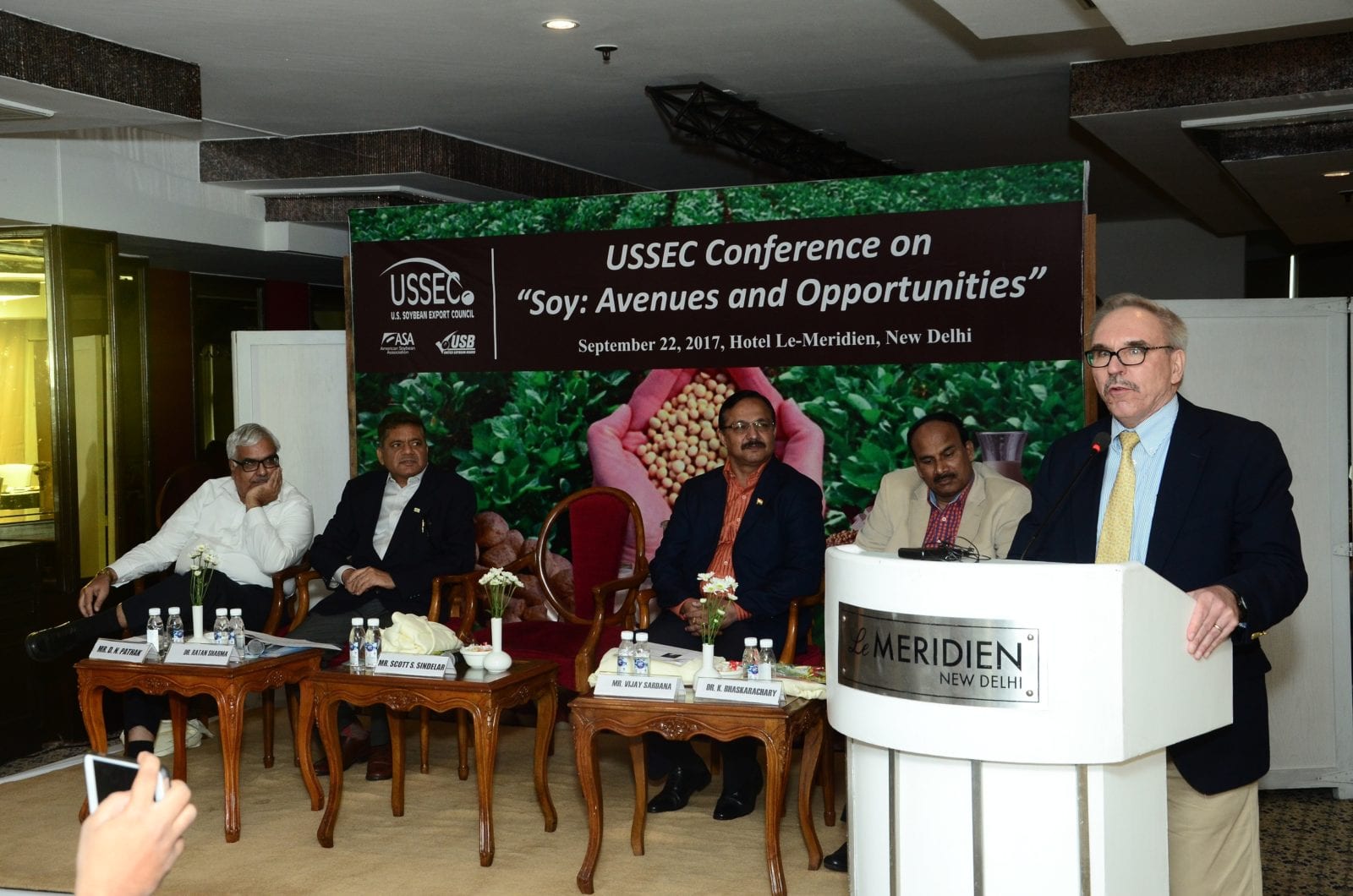USSEC Conducts Conference to Disseminate Knowledge on U.S. Soy in India
- Category:
- General News
- Soy Foods
- Soybean OIl

USSEC India conducted a conference, “Soy: Avenues and Opportunities,” in Delhi to provide tech and trade information on U.S. soybean oil and food grade soybeans. USSEC involved various stakeholders from the industry, government, academia, agricultural policy experts, U.S. Department of Agriculture (USDA), National Institute of Nutrition (NIN), and Soy Processors Association of India (SOPA), among others.
Scott Sindelar, Minister Counselor of Agriculture Affairs at the U.S. Embassy, New Delhi, addressed attendees, saying that the demand for soybeans is growing as food and animal feed needs continue to rise in India. “If India wants to increase production of soybeans to meet domestic demand, it should allow the use of innovative technologies or permit imports from the global market.” He further stressed that the existing processing capacity can be utilized by importing oilseeds and emphasized that India’s neighboring countries, including Bangladesh, started buying soybeans from overseas market and crushing them to meet their oil and soybean meal requirements.


Speaking about the role soy can play in the health and nutritional security of India, USSEC Director – India & ASC Soy Food Program Dr. Ratan Sharma stated that the soybean is one of very few plants that provide a high quality protein with minimum saturated fat. Soybeans help people feel better and live longer with an enhanced quality of life and contain all three macronutrients required for good nutrition, as well as fiber, vitamins, and minerals. Soy protein provides all the essential amino acids in the amounts needed for human health. The protein in just 250 grams of soybean is equivalent to protein in 3 liters of milk, 1 kilogram of mutton, or 24 eggs. In addition to being a rich source of nutrients, soybean has a number of phytochemicals (isoflavones), which offer health benefits along with soy protein. Soy protein and isoflavones together contribute to a number of health benefits such as cancer prevention, cholesterol reduction, heart health, combatting osteoporosis, and menopause regulation. Soy also plays an important role in helping diabetics maintain low sugar levels because of its low glycemic index.

Dr. Sharma talked about various soy products including soybean oil, soymilk, tofu, soy nuggets (texturized soy products [TSP]), soy fortified wheat flour and chickpea flour, soy protein isolate- and concentrate-based products, soy utilization in traditional products, and soy-based lentil analogue, suggesting that these products have been made by using high end processing technology, which is both tasty and safe for consumption. He further emphasized that soy could be an excellent solution to reduce the protein calorie malnutrition in India, and that the government should include soy as a main nutritional ingredient for various supplementary nutrition and welfare programs to ensure a healthy young generation. Soy-based formulations are popular in supplementary nutrition and school lunch programs run by the Indian government.
Dr. Sharma explained about the nutritional quality of U.S. soybean oil. In addition to regular nutritious soy oil, the U.S. has also developed high oleic soy oil. High oleic soy oil is very popular as an industry-preferred substitute for partially hydrogenated vegetable oils and is used in all manners of processed foods, especially snack foods for deep-frying. High oleic soy oil is free from trans fats as well as lower in saturated fat and contains three times the beneficial monounsaturated fatty acids compared to conventional soy oil.
Dr. Sharma pointed out that in August 2017, the U.S. Food and Drug Administration (FDA) approved Bunge North America’s petition for a qualified health claim linking soybean oil consumption to reduced risk of heart disease. Soybean oil is the most commonly used ingredient and top dietary source of polyunsaturated fats in the U.S. and is the second largest edible oil used in India. Soy oil is considered a heart-healthy oil; it is cholesterol-free and low in saturated fatty acids and contains 61 percent poly-unsaturated fatty acids. Two fat components essential for health and well-being, linoleic and linolenic acids, are also found in the right proportions in soybean oil. It is also a good source of vitamin E. Like fish oils, soybean oil contains omega-3, known to be protective against heart disease and cancer.
Discussing soy food business opportunities in India, Dr. Sharma emphasized that raw material plays a major role to produce a quality product delivering proper nutrients and making a tasty product. Food specialty soybeans are not grown in India, limiting the growth of the soy food sector in the lack of desired quality product with limited value addition possibilities. Dr. Sharma highly recommended food specialty soybeans from the U.S., which produce excellent quality soy food with a much better acceptability of the end product and excellent value addition possibility, as compared with Indian soybeans.
Other invited guest speakers spoke about the nutritional challenges and creating employment through the soy food business, regulatory updates, recently implemented Goods and Services Tax (GST) and its implication on soy foods, soy-based fermented food products, and snack foods. Mr. D.N. Pathak, SOPA Executive Director, stated that soy food is one of the fastest growing businesses in India with an annual growth rate of 8 to 10 percent. He advocated that the Indian government should consider including soy in the school feeding and social welfare programs with proper policy driven support. DuPont Nutrition presented about the protein rich foods and beverages made by using soy protein isolate and concentrates of U.S. origin and its rapid growth in India.

This program was attended by a large number of participants from the soy food industry, trade associations, scientists and nutrition professionals, agricultural products, edible oil traders / importers, and trade and regulatory experts. The event was widely covered by many leading print and electronic media giving popularity to U.S. soybeans, soy nutrition, and soy oil.